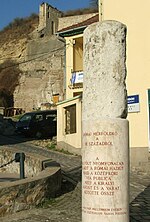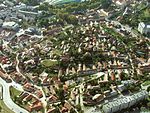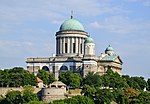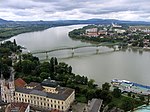Esztergom

Esztergom (Hungarian pronunciation: [ˈɛstɛrɡom] ; German: Gran; Latin: Solva or Strigonium; Slovak: Ostrihom, known by alternative names) is a city with county rights in northern Hungary, 46 kilometres (29 miles) northwest of the capital Budapest. It lies in Komárom-Esztergom County, on the right bank of the river Danube, which forms the border with Slovakia there. Esztergom was the capital of Hungary from the 10th until the mid-13th century when King Béla IV of Hungary moved the royal seat to Buda. Esztergom is the seat of the prímás (see Primate) of the Roman Catholic Church in Hungary, and the former seat of the Constitutional Court of Hungary. The city has a Christian Museum with the largest ecclesiastical collection in Hungary. Its cathedral, Esztergom Basilica, is the largest church in Hungary. Near the Basilica there is a campus of the Pázmány Péter Catholic University.
Excerpt from the Wikipedia article Esztergom (License: CC BY-SA 3.0, Authors, Images).Esztergom
11, Esztergomi járás
Geographical coordinates (GPS) Address Nearby Places Show on map
Geographical coordinates (GPS)
| Latitude | Longitude |
|---|---|
| N 47.785555555556 ° | E 18.740277777778 ° |
Address
11
2500 Esztergomi járás, Ripária
Hungary
Open on Google Maps











